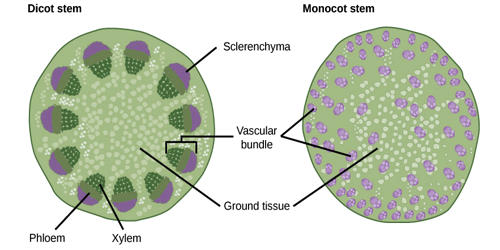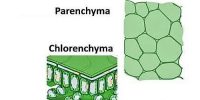Dicot stems have a well-defined epidermis with cuticle, a layer of dermis along with multicellular stem hair. Monocot stems are a circular-shaped stem with lateral branches and are bounded with a layer of the dermis. The internal structure of a dicot stem mainly consists of epidermis, hypodermis, cortex endodermis, pericycle, vascular strand, and pith. The internal structure of a monocot stem mainly comprises a well-developed epidermis, hypodermis, ground tissue, and numerous dispersed vascular bundles. Sunflower and Cucurbita are examples of dicot stems. Tulips, onions, lilies, and garlic are examples of monocot stems.
Difference between Anatomical Structures of Dicot stem and Monocot stem
Dicot stem
- Multicellular stem hair present.
- The hypodermis is composed of collenchyma tissue.
- Cortex can be differentiated into extrasolar and interstellar regions.
- The extrasolar cortex again can be differentiated into hypodermis, general cortex, and endodermis.
- Vascular bundle are, usually, fixed in number and are arranged in the ring
- The pericycle is present outside the vascular bundles.
- The bundle sheath is absent.
- Vascular bundles, conjoint collateral, or collateral type.
- Medulla and medullary ray present.
- The dicot stem is solid in most of the cases. The hypodermis is formed of collenchyma fibers which are often green in color.
- The internal tissues are arranged in concentric layers. The ground tissue is differentiated as endodermis, cortex, pericycle, medullary rays, pith, etc.
- The vascular bundles are formed as broken rings. Phloem parenchyma is present.
- Pith is well-developed. Vascular bundles are less in number and are of uniform size.
Monocot stem
- Stem hair absent.
- The hypodermis is composed of sclerenchyma tissue.
- Cortex can’t be differentiated into extrasolar and interstellar regions.
- From below the hypodermis, the cortex extends up to the center.
- Vascular bundles are numerous and are scattered in ground tissue.
- Pericyclic is absent.
- Bundle sheath is present and around the vascular ground tissue.
- Vascular bundles, conjoint collateral, and dosed type
- Medullary ray is not distinguished from the ground tissue.
- The monocot stem is usually hollow at the center. The hypodermis is made of sclerenchyma fibers, and they are not green.
- There is no concentric arrangement of tissues. The ground tissue is the same and is composed of a mass of similar cells.
- The vascular bundles are scattered irregularly around the ground tissue. Phloem parenchyma is absent.
- There are numerous vascular bundles of different sizes.
Another difference between monocot stem and dicot stem is that monocot stems contain numerous vascular bundles while dicot stems contain 4 to 8 vascular bundles. Monocot stems contain scattered vascular bundles across the stem while dicot stems contain vascular bundles arranged in the form of rings. Moreover, the outer vascular bundles are smaller than the inner vascular bundles in monocot stems while all vascular bundles are equal in size in dicot stems.
Furthermore, the vascular bundles of the monocot stem are surrounded by a sclerenchymatous bundle sheath while the vascular bundles of the dicot stem are not surrounded by a bundle sheath.













